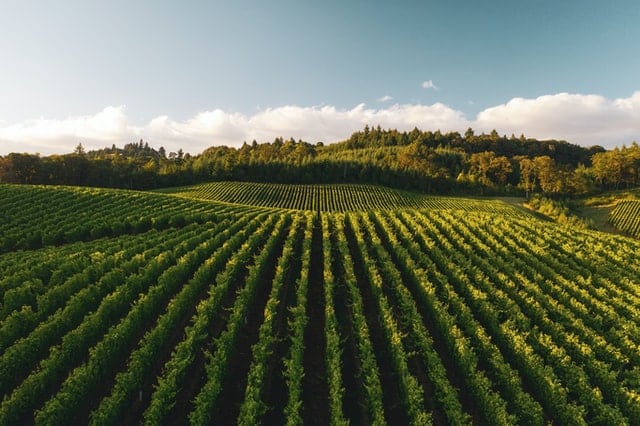
Farmland Investing: Impact Beyond Returns
This post may contain links from our sponsors. We provide you with accurate, reliable information. Learn more about how we make money and select our advertising partners.
The following is a sponsored post by FarmTogether, a fast-growing farmland investment manager powered by cutting-edge tech.
Farmland investing garnered more attention than ever in 2021, with Bill Gates making waves by becoming the largest private farmland owner in the United States; his total holdings currently sit at nearly 270,000 acres.
But why is Bill Gates buying up so much farmland?
The answer is simple: farmland investing can offer a hedge against inflation, a unique diversification opportunity, a low-volatility asset, a buy-and-hold investment to generate market-beating returns, and a chance for investors to put their money toward something impactful.
1.Portfolio Diversification
As an alternative asset, farmland sits outside conventional markets; farmland returns have been historically uncorrelated to those of stocks, bonds, and real estate, as well as broad economic cycles and market conditions.
What this means for investors is that events that impact the stock market, like changes in interest rates or exogenous shocks like the Covid-19 pandemic, should not impact farmland investments.
Farmland can be an integral tool for investors looking to diversify their portfolios.
2. Historically Strong Returns
Farmland isn’t just a good portfolio diversifier—it has also delivered consistently strong returns over the past several decades. In fact, the NCREIF Farmland Total Return Index has increased more than 20x over the past 30 years.
Further, the value of the average acre of farmland has increased per decade since the 1990s, maintaining its value irrespective of recessions and other moves that shook the markets. As the 2008 financial crisis gripped Wall Street, for example, farmland values soared.
The total value of American farmland grew from $1.4 trillion in 2000 to an estimated $2.8 trillion by 2021. There’s no reason to expect this trend to reverse, especially given the country’s shrinking amount of arable farmland and the expanding global need for food.
3. Inflation Hedge
Farmland has historically been one of the best inflation hedges, outperforming both gold and commercial real estate. In fact, the NCREIF Farmland Index’s Total Return has consistently provided returns more than double the inflation rate since before 1992.
Farmland produces commodities that are always in demand and tend to increase in price when inflation is on the rise, in turn increasing the value of the land itself. Thus, farmland is uniquely suited to hold its value when inflation swells.
4. Low Volatility, Low Correlation
As displayed above, farmland investing is considered a low-volatility investment; farmland has historically experienced less volatility than traditional and alternative asset classes and enjoys low correlation with the stock market.
Whether markets are up or down, farmland value remains unaffected. This makes farmland an excellent option for investors looking to stabilize their portfolios, especially amidst market downturns.
5. Passive Income
Investing in farmland can also be a great passive income source. With farmland, investors can benefit from rental payments from operating partners, income generated by crop sales, and land price appreciation at the end of the hold period.
Often considered a triple revenue source, farmland can be a fruitful passive income stream.
6. Impact Investing with Farmland
Arable farmland is a finite resource. According to the most recent agricultural census, the amount of farmland in the United States has shrunk from 914.5 million acres in 2012 to 900.2 acres in 2017. There’s no sign that this trend is abating, either.
Despite shrinking farmland availability, the national and global need for food is set to grow exponentially. Research concludes that the global population will reach 10 billion people in the next 30 years, accounting for 3 billion more people to feed than in 2010. With more mouths to feed and less land available, the world will rely on fewer farms to produce more food.
Meeting these demands will only be possible through innovation, which is only affordable when investors step in to help farmers find the right solutions. And, farmland investing doesn’t only mean helping to feed a growing population. Investments in farmland translate into sustainable solutions for the planet. Innovative new irrigation methods, efficient carbon-smart farming techniques, and other environmentally focused agricultural practices are only possible when investors get involved.
Farmland Investing: Now Accessible
The benefits of farmland investing are vast, and the advent of platforms like FarmTogether has finally made it possible for a bigger pool of investors to get involved.
You can now add institutional-quality farmland to your portfolio online, in minutes, with as little as $15k.
In an economic climate rife with uncertainty and volatility, farmland is providing investors with shelter from the storm, as well as a long-term proposition for steady, market-beating returns.
Disclaimer: The topic presented in this article is provided as general information and for educational purposes. It is not a substitute for professional advice. Accordingly, before taking action, consult with your team of professionals.

